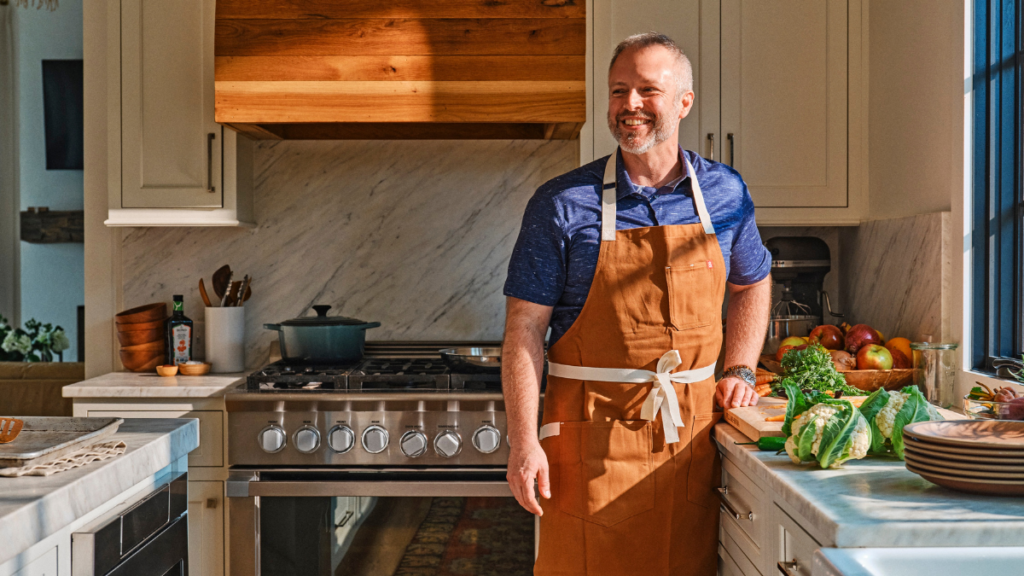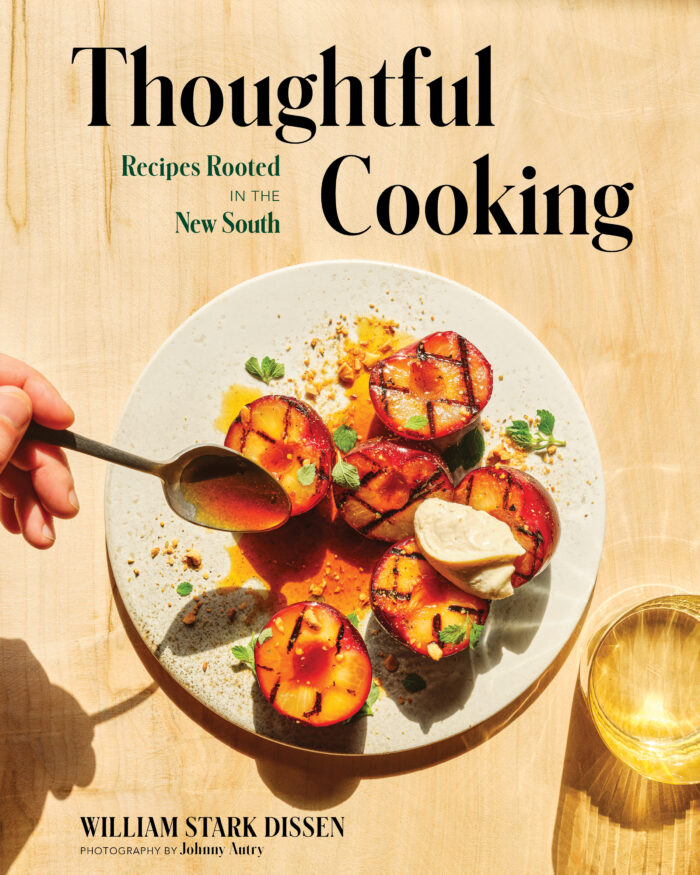Digging Into Halloween’s Rich History, This West Virginia Morning
Halloween is more popular than ever. We speak with WVU religious studies professors to learn more about the holiday's rich history.
Continue Reading Take Me to More News
This conversation originally aired in the Nov. 24, 2024 episode of Inside Appalachia.
Food has a way of carrying our deepest memories, and for Chef William Dissen, those memories are seasoned with the flavors of West Virginia’s mountains. Now, at his James Beard-nominated restaurant, The Market Place in Asheville, North Carolina, Dissen transforms those Appalachian traditions into award-winning cuisine.
Named “Green Chef of the Year” twice by FORTUNE magazine, Dissen has built his reputation on sustainable cooking practices and supporting local food systems throughout the Appalachian region. As a Seafood Watch Ambassador and member of the American Chefs Corps, he advocates for food policy and promotes sustainable American food culture nationally and internationally.
Folkways Reporter Margaret Leef caught up with the chef at Charleston’s Capitol Market, where he shared how his mountain roots inspired his debut cookbook, Thoughtful Cooking: Recipes Rooted in the New South.
This interview has been edited for length and clarity.
Leef: You write about learning to garden and cook alongside your grandmother in West Virginia. What was a typical day with her, from picking vegetables to getting dinner on the table?
Dissen: One of my most vivid memories, just as a human but also as a chef, is growing up and being at my grandmother Jane’s farm in Sandyville, West Virginia. [My grandparents] lived up in the holler, and they had a nice house and garden right along the creek side. Their garden had bees to pollinate the garden, and they had a canning shed adjacent to the garden and a small barn.
One of my most vivid memories was peak summer, probably mid-August — you could feel the humidity hanging in the holler. And my grandmother said, “All right, Billy, go get some corn.” And I remember running out in the field and waddling back as a young kid, arm full of corn. And we sat on the front porch and shucked it. And she had a pot of salt water going on the stove, and we boiled it. I remember slathering it, probably with Country Crock, and putting some salt on it. And my head exploded off my shoulders, and it was like, I’ve never tasted corn before until this day. It was really inspiring because I felt like I learned something about food and connection to nature and why things taste a certain way when they’re grown locally, fresh and ripe. And that didn’t really hit me until later in life. It’s a moment I think back about quite a bit.
Leef: So, those experiences clearly shaped how you cook today.
Dissen: One hundred percent. Fast forward — I’m very fortunate — I went to culinary school at the Culinary Institute of America in New York, and when I was there, 13 master chefs were teaching. To put it in perspective, there are only about 65 [master chefs] in the world. So, I was very blessed to have some of the best chefs teaching me. I remember this one French chef, and I won’t imitate his accent, but he said, “If you want to be the best chef, you have to use the best ingredients.”
At the time, he was using things like foie gras, truffles and caviar. As I formulated my palette as a chef and the recipe repertoire that I wanted to use, I had an “aha” moment, really regressing back and remembering that experience at my grandmother’s farm and thinking, “You know, if I want to be the best chef, I need to use fresh ingredients, because fresh is best.”
Leef: You’ve written your first cookbook. I’m wondering why it’s important to you to have written this cookbook. And also, why now?
Dissen: For years, I was trying to figure out what my story was to tell. Being from Appalachia, we’re all storytellers here, right? There’s a lot of written history and a lot of verbal history. But, for me, the story was about the connection to our community, to the heritage we have here in Appalachia, and to the connection we have to the earth.
I’m not a Greenpeace hippie by any means, but what I learned from my grandparents was about the importance of taking care of nature and taking care of your community. For them, they didn’t poison their fields with chemicals because they wanted to be able to till and grow. There were weeds in the fields, and they said, “Those weeds are good, we till them back into the field, they add nutrition into the soil.” Honey bees to pollinate the garden … These were things that I didn’t understand as a child.
If you look at that connection to nature, you realize it’s all very cyclical and connected. After my travels, educating myself, and finding my way back to Asheville and Appalachia, I started having these “aha” moments. I love city life. I love the energy, the noise in the city and the people. But when you get into the mountains, you can get lost in the woods and take a hike and listen to a stream or waterfall. There’s this connection you have that you don’t get anywhere else.
The beauty of Appalachia, really, was kind of calling me home. Finding myself back there, it felt like I had this story to tell people about that — from being able to travel around the world and travel around the country. People have these ideas of who we are as Appalachians — hillbillies or rednecks, we’re all related to one another … But I think when they get here, they visit and meet people like us. They realize that we are some of the best people around — in our culture, in our history — and our heritage is really deep.

Leef: I noticed the word “thoughtful” in the cookbook’s title. Can you tell me more about that? What do you mean by “thoughtful cooking?”
Dissen: It’s like peeling the layers of an onion back. There’s this idea of cooking with intention, right? Planning a meal out? We have a French term called “mise en place,” and it literally means everything in its place. But it’s also the prep you make, the things you cut and prepare as you want to cook in the kitchen.
What’s also thoughtful [is] thinking about who you’re getting your food from. How are they growing the food? Are you growing the food? What are you doing to take care of the earth? Are you doing things that help the community around you? And then, even bigger picture … I believe in sustainability very deeply, but I’m not out hitting people over the head with it. I believe we should implement those ideals into our day-to-day lives. Because if we want our next generation, and the generation after that, to have nice things like we have, we have to take care of them. And this idea that we can all do little things by eating and cooking thoughtfully. Go to the farmers market. Talk to the growers growing delicious and nutritious food and try it. Even if you’re scared of an ingredient, you know what? Be brave. Go out and try something new.
Leef: What would you say are the tastes of Appalachia? How would you describe what Appalachian cuisine tastes like?
Dissen: I was really fortunate — few years back, I got asked to do a TV show with this very famous chef named Gordon Ramsay. And he asked me to be an ambassador for his TV show, to show him through central Appalachia and the Smoky Mountains, the Blue Ridge Mountains. I took him out, and we went foraging, and we went fly fishing and cooked a lot of Indigenous ingredients and Cherokee dishes. After the show, we sat down and talked. He told me he had traveled the world ten times over. He said Appalachia reminded him of places like Tuscany, Italy, that are world-renowned for their cuisine, the heirloom ingredients, the heritage cooking techniques and the sense of place. He said he had never been to a place like this. He couldn’t believe the world wasn’t just putting us all up on a pedestal.
Leef: You serve Appalachian-influenced cuisine at your restaurant in Asheville, The Market Place. I’m sure people come to that restaurant because they are seeking a taste of home, and then you have people who’ve maybe never tasted some of these dishes or flavors. What reactions do you get from people inside Appalachia and people passing through from outside Appalachia?
Dissen: You know, I always joke the Appalachian “gateway drug,” or gateway ingredient, is ramps. People say, what’s a ramp? I say it’s like a wild onion, a wild garlic that grows in the forest. It’s not cultivated, and it only grows for a month of the year. We try to get it, pickle it, preserve it, and keep it to have that flavor throughout the year. People taste it, and they say this is a really delicious flavor, especially if you’re a garlic fan. Ramps are like garlic on steroids.
So there are flavors of wild food, foraged food and wild mushrooms. There are the flavors of campfire cooking and rich, hearty dishes that stick to your soul. Those are things that people talk a lot about.
Southern food [is] quintessential American cuisine. But Appalachia is the backbone of the South. And our cuisine really is wrought in our history and heritage. Not just of modern America, but also historically, of Native American cuisine, that hunter-gatherer background, and food of necessity.
Leef: I’m thinking about Thanksgiving. Obviously, in Asheville, that’s going to look different for a lot of people. I’m also wondering what some of the Thanksgiving dishes you have around your table are.
Dissen: I worked with Slow Food USA for one of my favorite ingredients. They have the Ark of Taste, where they preserve different heirloom ingredients. One of them is really near and dear to me: the candy roaster squash — this type of hearty squash pumpkin that was cultivated originally by the Cherokee of central Appalachia. It’s this long, banana-looking squash shape. And the flavor is really delicious to me. So, we love to make a candy roaster squash soup out of it. Roast it off slowly, nice and caramelized, and cook it slow and low into really delicious pureed soup.
I also love stuffing. Many people don’t like it, but I love good, crispy, chewy stuffing. And I love mushrooms. This time of year, a wild mushroom called a maitake, or a hen of the wood mushroom is in season. We love to roast it and fold it into our stuffing. To me, it adds a depth of flavor.
I also love soup beans and cornbread, which are quintessential Appalachian cuisine. But over Thanksgiving, just setting a meal together, and regardless of your background or culture, I think that idea of setting the Appalachian table and sitting with your family and sitting with your friends and sharing a meal is really quintessential to who we are as a culture and community.
——
This story is part of the Inside Appalachia Folkways Reporting Project, a partnership with West Virginia Public Broadcasting’s Inside Appalachia.
The Folkways Reporting Project is made possible in part with support from Margaret A. Cargill Philanthropies to the West Virginia Public Broadcasting Foundation. Subscribe to the podcast to hear more stories of Appalachian folklife, arts and culture.